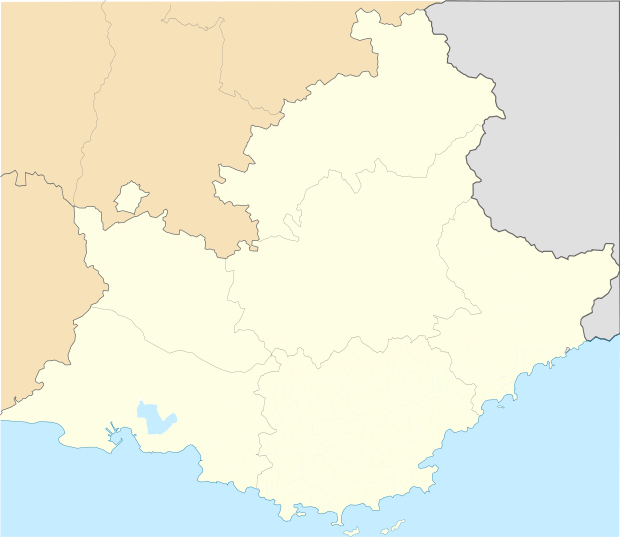Valensole
Valensole is a commune in the Alpes-de-Haute-Provence department in southeastern France.
Valensole | |
|---|---|
 Coat of arms | |
Location of Valensole 
| |
 Valensole  Valensole | |
| Coordinates: 43°50′20″N 5°59′04″E | |
| Country | France |
| Region | Provence-Alpes-Côte d'Azur |
| Department | Alpes-de-Haute-Provence |
| Arrondissement | Forcalquier |
| Canton | Valensole |
| Government | |
| • Mayor (2008–2014) | Gérard Aurric |
| Area 1 | 127.77 km2 (49.33 sq mi) |
| Population (2017-01-01)[1] | 3,204 |
| • Density | 25/km2 (65/sq mi) |
| Time zone | UTC+01:00 (CET) |
| • Summer (DST) | UTC+02:00 (CEST) |
| INSEE/Postal code | 04230 /04210 |
| Elevation | 290–651 m (951–2,136 ft) (avg. 595 m or 1,952 ft) |
| 1 French Land Register data, which excludes lakes, ponds, glaciers > 1 km2 (0.386 sq mi or 247 acres) and river estuaries. | |
The inhabitants are called "Valensolais".
The commune numbered 3,204 inhabitants in 2017.
Geography
The city itself, at 595 meters above sea level, is formed by an amphitheater on a hill between the Plateau de Valensole and the valley of Notre Dame. The commune is one of the most expansive of the region and contains many hamlets.
The river Asse forms most of the commune's northern border, then flows into the Durance, which forms all of its western border.
Geology
The beginning of the Tertiary era is marked by the lifting of the Pyrenees Mountains between 60 and 40 Ma. The repercussions of the lifting formed in the region of Valensole big mountains and little mountainous chains : Lure, Ventoux, Luberon, Nerthe, Étoile..., oriented east-west. During the Pyrenean raising, the Durance fault was active. The west lowered and the east raised, demarcating a vast river-lake zone : the Forcalquier basin, that receives, among others, the sediments coming from the east zone. For 15 thousand years, the Alps continue their formation. The powerful geologic movements accentuate again the east-west fold of the Provencal chains and mountains. The Durance fault is demonstrated once again. The occidental zone raises while the oriental zone sunk, forming a large depression in which waters of the ancestral torrents flowed, coming from south of the Estérel-Corso-Sarde Mountains. These powerful rivers, fed by violent climate phenomenons, transport large quantities of materials : pebbles, sand, clay, soluble limestone, taken into the depression where they accumulate to form an enormous deposit of Valensole's "poudingues", resulting from thousands of years of erosion in a karst environment.
Toward 8 Ma, the Estérel-corso-sardre mountain collapsed, isolating Corsica and Sardinia from the continent, which profoundly modified the hydrographic network. The rivers of Base-Provence that flow toward the plateau of Valensole and toward the Mediterranean Sea. The filling has followed from 5 or 6 thousand years. The visit deposit of Valensole is constituted by layers of pebbles more or less crude without the origins and the currents. The pebbles are cemented in different ways between the following - deposits, compressions, which demarcate the last layers and the layers most crumbly. The height of these deposits reach 838 meters toward Fourevière on the limit of the commune of the Mées and of Puimichel (between Guillot and the Allemands), and 400 meters on the heights of Volonne. Under the weight of this mass of materials, the terrestrial exterior sunk, that provokes movements of the deposit edge.
The levels move, tumble, subside, provoking folds and faults. The accumulation of conglomerates of Valensole spreads out for around 10 thousand years. Toward 3 Ma, the filling-in stopped.
The rivers will rearrange their valleys through the poudingue and the pluvial, glacial, fluvial, erosion will cut the relief of the plateau in forming small valleys and hills.
Relief
Hydrography
Environment
Climate
Transportation
Natural and Technological Risks
Neighboring Towns
Hamlets
Town Planning
Perched Village
Toponymy
History
Antiquity
The Middle Ages
Modern Times
French Revolution
Contemporary Times
Politics and Administration
Political Tendencies and Results
List of Mayors
Taxation
Environment and Recycling
Public Services
Population and Society
Demography
| Year | Pop. | ±% |
|---|---|---|
| 1765 | 3,117 | — |
| 1793 | 3,532 | +13.3% |
| 1806 | 3,566 | +1.0% |
| 1821 | 3,281 | −8.0% |
| 1831 | 3,521 | +7.3% |
| 1836 | 3,284 | −6.7% |
| 1841 | 3,135 | −4.5% |
| 1846 | 3,049 | −2.7% |
| 1851 | 3,151 | +3.3% |
| 1856 | 3,134 | −0.5% |
| 1861 | 3,072 | −2.0% |
| 1866 | 3,021 | −1.7% |
| 1872 | 3,186 | +5.5% |
| 1876 | 3,065 | −3.8% |
| 1881 | 3,020 | −1.5% |
| 1886 | 2,907 | −3.7% |
| 1891 | 2,807 | −3.4% |
| 1896 | 2,624 | −6.5% |
| 1901 | 2,550 | −2.8% |
| 1906 | 2,509 | −1.6% |
| 1911 | 2,357 | −6.1% |
| 1921 | 1,917 | −18.7% |
| 1926 | 1,924 | +0.4% |
| 1931 | 1,960 | +1.9% |
| 1936 | 1,966 | +0.3% |
| 1946 | 1,790 | −9.0% |
| 1954 | 1,784 | −0.3% |
| 1962 | 1,712 | −4.0% |
| 1968 | 1,791 | +4.6% |
| 1975 | 1,721 | −3.9% |
| 1982 | 1,944 | +13.0% |
| 1990 | 2,202 | +13.3% |
| 1999 | 2,334 | +6.0% |
| 2008 | 2,875 | +23.2% |
Education
Cultural Manifestations and Festivities
Health
Sports
Economy
Agriculture
Industry and Crafts
Service Activities
Local Culture and Property
References
- "Populations légales 2017". INSEE. Retrieved 6 January 2020.
| Wikimedia Commons has media related to Valensole. |